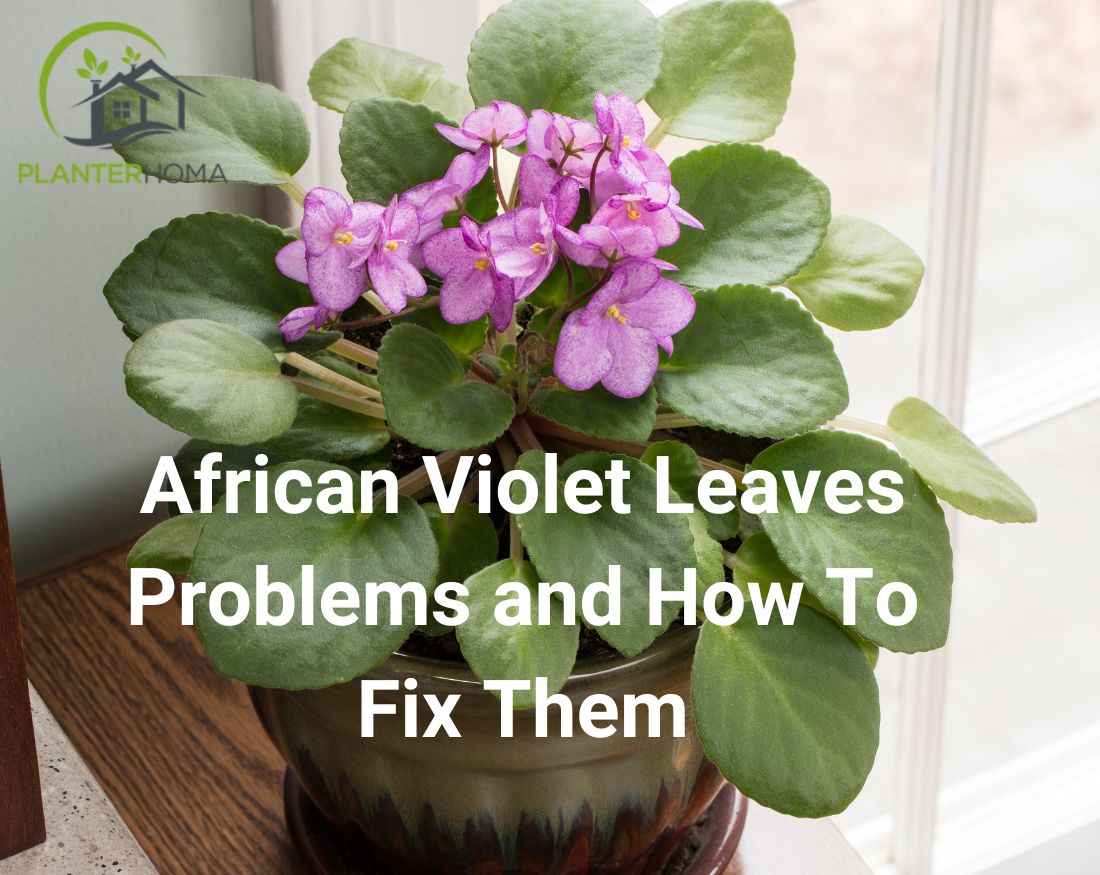African Violet Troubleshooting: Expert Tips for Healthy Growth
African violets are beautiful and popular houseplants. Yet, they can sometimes face issues.
In this guide, we’ll explore common problems and their solutions. African violets are cherished for their vibrant blooms and lush leaves. But, like all plants, they can encounter various troubles. Leaves may turn yellow, blooms might fade, or pests could invade.
Understanding these issues helps keep your plants healthy. This guide will walk you through diagnosing and fixing common problems. Whether you’re a beginner or an experienced grower, this troubleshooting advice will help your African violets thrive. Stay tuned to learn how to identify and solve the most common African violet issues. Your plants will thank you!

Credit: planterhoma.com
Common Growth Issues
African violets are beloved houseplants known for their vibrant blooms. But sometimes, they face growth issues. Understanding these problems can help keep your plants healthy.
Wilting Leaves
Wilting leaves often indicate water issues. Overwatering can suffocate roots. This prevents them from absorbing nutrients. On the other hand, underwatering can dry out the plant. Check the soil regularly. It should be moist but not soggy.
Another cause could be poor light conditions. African violets need indirect light. Too much direct sunlight can scorch the leaves. Too little light, and they may wilt. Place your plant in a bright spot, away from direct sun.
Pest infestations can also cause wilting. Look for signs of pests like aphids or spider mites. Treat them with appropriate insecticides.
Stunted Growth
Stunted growth may result from inadequate nutrients. African violets need balanced fertilizers. Use a water-soluble fertilizer every two weeks. Ensure it is rich in phosphorus for better blooms.
Incorrect pot size can hinder growth. A pot that is too big retains excess water. This can lead to root rot. Use a pot that is just slightly larger than the root ball.
Temperature stress can also affect growth. African violets thrive in temperatures between 65-75°F. Keep them away from cold drafts or heat sources. Stable temperatures encourage healthy growth.
Lastly, check for root-bound issues. Roots may become tangled in small pots. This restricts their growth. Repot the plant in fresh soil to give roots more room.
Optimal Light Conditions
Optimal Light Conditions are crucial for the healthy growth of African Violets. These delicate plants require the right amount of light to bloom and thrive. Too much or too little light can lead to various problems. In this section, we will discuss the best natural and artificial light conditions for your African Violets.
Natural Light
African Violets thrive best in natural light. Place them near a window where they can receive bright, indirect sunlight. Direct sunlight can scorch the leaves, so ensure the light is filtered. A north or east-facing window is ideal. Monitor the light intensity and adjust the plant’s position as needed.
Use sheer curtains to diffuse the light if it’s too intense. Rotate the plant regularly to ensure even light exposure. This practice helps prevent the plant from leaning towards the light source.
Artificial Light
Artificial light can be a good alternative if natural light is insufficient. Use fluorescent or LED grow lights for the best results. Position the lights 12-15 inches above the plant. Ensure the light is on for 12-14 hours a day.
Consider using a timer to automate the lighting schedule. Avoid incandescent bulbs as they produce too much heat. Adjust the light intensity based on the plant’s response.
| Light Type | Distance | Duration |
|---|---|---|
| Natural Light | Bright, Indirect | Varies |
| Fluorescent Light | 12-15 inches | 12-14 hours |
| LED Grow Light | 12-15 inches | 12-14 hours |
Remember, the right light conditions are vital for the health of your African Violets. Monitor and adjust as needed to ensure your plants bloom beautifully.
Watering Techniques
African violets are beloved for their beautiful blooms and lush foliage. Yet, improper watering can lead to various problems. Understanding proper watering techniques is crucial for their health.
Proper Frequency
Watering frequency depends on the environment. Generally, water African violets when the soil feels dry. Overwatering can cause root rot. Underwatering can make leaves wilt. Check your plant every few days.
Watering Methods
Several methods exist for watering African violets. Top watering involves pouring water directly onto the soil. Use a watering can with a narrow spout. Avoid getting water on the leaves. Wet leaves can lead to spots or rot.
Bottom watering is another method. Place the pot in a shallow dish of water. Let the plant soak up water through the drainage holes. Remove the pot after 30 minutes. This method prevents water from sitting on the leaves.
Self-watering pots are also an option. These pots have a reservoir that supplies water to the soil. They maintain consistent moisture levels. Check the reservoir regularly to ensure it has enough water.
Choosing the right watering method is key. It ensures your African violets thrive and bloom beautifully.

Credit: threepsandq.com
Soil And Fertilizer
African violets are popular houseplants. Their vibrant blooms and lush leaves brighten any room. To keep them thriving, understanding their soil and fertilizer needs is crucial. The right soil and nutrients ensure healthy growth and beautiful flowers.
Soil Types
African violets prefer well-draining soil. Regular garden soil is not ideal. It holds too much water. Choose a potting mix designed for African violets. This type of soil allows air to reach the roots. It prevents root rot and promotes healthy growth. You can find these mixes at most garden centers.
Nutrient Needs
African violets need balanced nutrients. Use a fertilizer made for them. It usually contains equal parts nitrogen, phosphorus, and potassium. Follow the instructions on the package. Over-fertilizing can harm the plant. Fertilize every four to six weeks. This schedule provides consistent nutrients. Your plant will reward you with vibrant blooms.
Pest Control
Maintaining the health of your African Violets means keeping pests at bay. Pests can cause significant damage to your plants. They disrupt growth and can even lead to plant death. Effective pest control involves identification and treatment. Let’s dive into two key aspects: identifying pests and natural remedies.
Identifying Pests
Several pests can infest African Violets. Here are some common ones:
- Aphids: Small, green or black insects. They cluster on new growth and undersides of leaves.
- Mealybugs: White, cotton-like masses on leaves and stems.
- Spider Mites: Tiny, red or brown dots. They create fine webs on the plant.
- Thrips: Tiny, slender insects. They cause distorted leaves and flowers.
- Fungus Gnats: Small, black flies. Their larvae live in soil and feed on roots.
Natural Remedies
Natural remedies can help control pest infestations. They are safe for your plants and the environment. Here are some effective options:
- Neem Oil: Mix neem oil with water. Spray it on affected areas. It disrupts pest life cycles.
- Insecticidal Soap: Use a mild soap solution. Spray it directly on pests. It suffocates them.
- Diatomaceous Earth: Sprinkle on soil surface. It dehydrates and kills pests.
- Sticky Traps: Place yellow sticky traps near plants. They attract and trap flying insects.
- Garlic Spray: Blend garlic with water. Spray it on the plant. It repels many pests.
Regular monitoring and early intervention are key. This ensures your African Violets stay healthy and vibrant.

Credit: planterhoma.com
Managing Humidity
African violets thrive in specific conditions. One critical factor is humidity. Managing humidity levels ensures your plant stays healthy and blooms beautifully. Let’s explore how to achieve the right balance.
Ideal Levels
African violets prefer humidity levels between 40% and 60%. Levels below 40% can cause the leaves to dry out. On the other hand, too much humidity can lead to mold and rot. Keeping humidity within this range is crucial for healthy growth.
Humidity Tools
Using a hygrometer helps monitor humidity levels. This tool is easy to find and use. Place it near your plants for accurate readings. Another useful tool is a humidifier. It adds moisture to the air, especially in dry environments. Choose a model suitable for your room size.
In low-humidity areas, try using pebble trays. Fill a shallow tray with water and pebbles. Place your plant pot on top. The water evaporates, increasing the humidity around the plant. Misting the leaves lightly can also help, but avoid overdoing it to prevent fungal issues.
Grouping plants together can create a microenvironment with higher humidity. Plants naturally release moisture into the air. This collective moisture benefits all plants in the group.
Balancing humidity is essential for African violets. Use these tools and tips to create the perfect environment for your plants.
Repotting Practices
Repotting African Violets can be a delicate task. Proper repotting practices ensure these beautiful plants thrive and bloom. Here, we will discuss when to repot and the essential steps involved.
When To Repot
Knowing when to repot your African Violet is crucial. Look for these signs:
- Roots are growing out of the drainage holes.
- Soil dries out faster than usual.
- The plant looks top-heavy and wobbly.
- Leaves are crowded and overlapping.
- The plant has stopped blooming.
Repotting is generally recommended every 6 to 12 months. Regular repotting ensures healthy growth and blooming.
Repotting Steps
Follow these repotting steps for best results:
- Prepare the New Pot: Choose a pot one size larger. Ensure it has drainage holes.
- Remove the Plant: Gently remove the plant from its current pot. Loosen the soil around the roots.
- Trim the Roots: Trim any dead or damaged roots. This encourages new growth.
- Refresh the Soil: Use fresh, well-draining potting mix. African Violets prefer a specific mix.
- Place the Plant: Center the plant in the new pot. Fill around it with soil, leaving space at the top.
- Water Lightly: Water the plant lightly to settle the soil. Avoid overwatering.
- Adjust the Position: Place the plant in a spot with indirect light. Avoid direct sunlight.
Following these steps helps ensure your African Violet will adapt and flourish in its new pot. Happy repotting!
Pruning And Grooming
Pruning and grooming your African violets are essential tasks. They ensure your plants stay healthy and look their best. Regular pruning helps manage the plant’s shape and encourages new growth. Grooming involves removing dead leaves and spent flowers. This keeps your plant tidy and free from disease.
Removing Dead Leaves
Dead leaves can attract pests and diseases. Removing them is an important part of grooming. Use clean, sharp scissors or your fingers. Gently twist the leaf at the base until it comes off. Be careful not to damage the main stem.
Check your plant weekly for dead leaves. Remove any you find right away. This routine keeps your plant healthy and looking good.
Promoting New Growth
Pruning helps promote new growth. This makes your African violet fuller and more vibrant. To encourage new growth, pinch off the tips of the plant’s stems. This will stimulate the plant to produce new shoots.
Another method is to remove older, larger leaves. This allows more light to reach the inner parts of the plant. It encourages new leaves to grow.
Regular pruning and grooming not only improve the plant’s appearance but also its health. Your African violet will reward you with beautiful blooms and lush foliage.
Frequently Asked Questions
Why Are My African Violet Leaves Turning Yellow?
Yellow leaves often mean overwatering. Check soil moisture. Ensure the pot has good drainage.
How Can I Revive A Wilting African Violet?
Wilting may mean underwatering. Water your plant thoroughly. Ensure it’s not in direct sunlight.
What Causes African Violet Leaves To Curl?
Curling leaves can indicate too much light. Move the plant to a shadier spot.
Why Is My African Violet Not Blooming?
Lack of blooms can be due to low light. Use a grow light for better results.
How Do I Treat African Violet Pests?
Pests can be treated with insecticidal soap. Spray leaves and stems. Repeat as needed.
Conclusion
Caring for African Violets can be challenging, but it’s rewarding. Addressing common issues helps plants thrive. Check light, water, and soil conditions regularly. Keep an eye out for pests and diseases. Healthy African Violets brighten any home. Stay patient and consistent with care.
Happy gardening!






